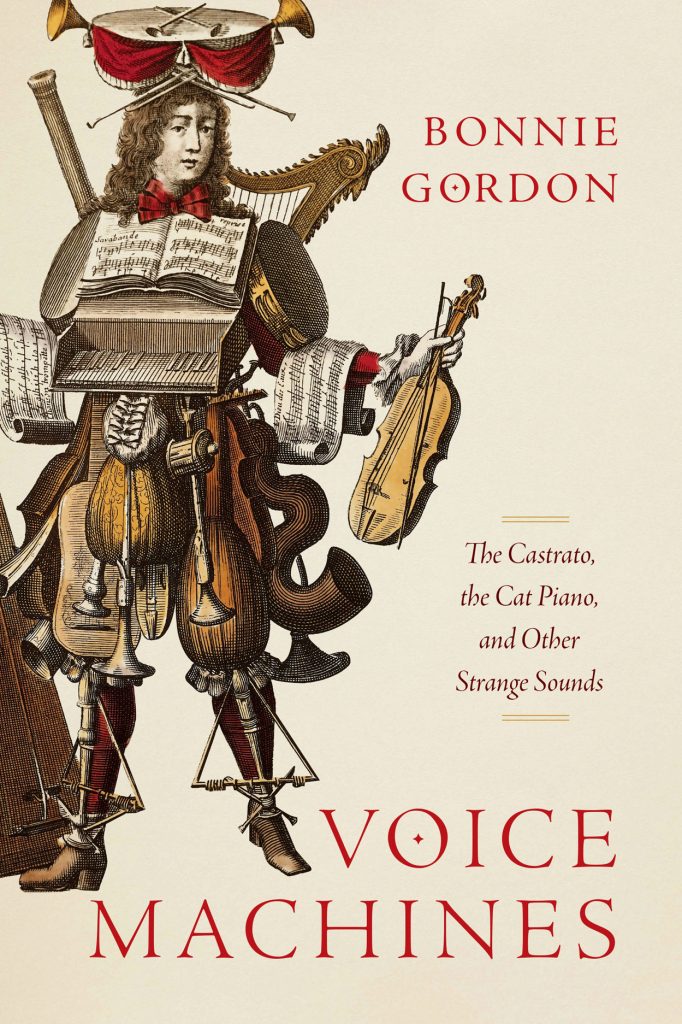Digging into sound Bonnie Gordon’s Voice Machines is sensory, contemplative, and visionary
Article written by Sarah Lawson and appeared in C-Ville Weekly on 7/20/23
In Voice Machines: The Castrato, the Cat Piano, and Other Strange Sounds, Bonnie Gordon explores the castrato as a cultural phenomenon and a critical mode of inquiry into the technological relationships that have existed between humans, machines, sounds, and instruments, from early modern to contemporary times. We interviewed the UVA professor of music and co-director of the Sound Justice Lab to find out more about this gorgeously sweeping, multidisciplinary book that is equal parts historical and visionary.

C-VILLE: From Greek myths and Monteverdi to Donna Haraway and Nick Cave, from sound theory and queer theory to posthumanism and the politics of desire, your new book looks at the voice as a technological and theoretical intervention that has shaped history and culture. The book’s scope is immense, each chapter a divergent constellation that reads like it could be a book unto itself despite being deeply connected to the whole. You write that, “The castrato is a critical provocation for asking several questions about the interrelated histories of music, technology, sound, the limits of the human body, and what counts as human.” Could you describe how such expansive research evolved over time?
Bonnie Gordon: I gave my first academic paper on the castrato when I was pregnant with my twins. [Voice Machines] came out after their sophomore year of college. A book that takes so long must take conceptual twists and turns. I thought I was writing a book on castrati in 16th- and 17th-century Roman festivals. And then I took my first archival trip to Rome. I spent hours wandering the streets with little twins in a double stroller. I entertained them by chasing modern Roman spectacles, looking for il Papa, visiting the Swiss Guards, watching fireworks, splashing in fountains. The kids turned me on to the sensory world of Rome and enticed me to think about the city as a vibrant, living space. I found it endlessly fascinating to feel the multiple layers of history; to sit on a yellow plastic bench next to a Baroque church on top of an ancient building. The book had to incorporate those layers, it had to capture the sensory experience of castrati as somewhere between a mythological past and an imagined future.
You also note opportunities for “historiographical reharmonization” around the study of castrati, writing, “Sound in this book is not just acoustical resonance, much less is it just musical or vocal. Rather it constitutes an interface.” Could you discuss how musical metaphors as well as structures like harmonies and refrains influence your work?
The book digs into sound; not just music but the way the world sounded before car alarms and microphones, and it understands sound and listening as central to the way humans experience their worlds. But I don’t think of music-inflected language as metaphor. I’m trained as a classical musician and a traditional music historian, so my mind works in those terms. For example, if you reharmonize a tune you essentially play the same melody with a different chord progression. It can feel totally different and usually it’s a little more gritty; a bit more uncomfortable. This is what I do when I take a text from the 18th century that describes the castrato procedure that has been read as if it is a description of a medical procedure and instead read it as a satire directed against Italians.
But also, I suspect I’m drawn to theoretical approaches that seem musical. The concept of refrain comes from Giles Deleuze and Felix Guattari. They use the concept of musical refrain to think of history as a series of possible relations to the past. And in some fundamental way the castrato does—in this book at least—turn out to be a figure created by stories or refrains that sound across time and space.
Finally, you write about the effects that life, as well as local and world events, had on your work. You reflect, “I’ve been doing a kind of sonic witnessing… Knowledge production, it turns out, isn’t just what you read; it’s where and with whom you happen to be.” How does this show up in your work?
The most direct answer is that my scholarship pivoted when I started teaching at UVA in 2007, which was the 400th anniversary of the Jamestown settlement. I was organizing a conference at my former institution for a different 400th anniversary—the premiere of Monteverdi’s L’Orfeo—and needed a score of a Handel opera. The library search engine sent me to Special Collections, which seemed odd for such a popular tune. Unfamiliarity with a new search engine had led me to a piano reduction from Thomas Jefferson’s music collection. Since that archival accident, I’ve made a practice of collecting sonic snippets that connect the music history I study and teach to local history and the present. The phrase “sonic witnessing” came from my colleague and mentor Deborah Wong. In 2018, I gave a keynote lecture about Zora Neale Hurston. Then, as now, I found myself thinking about the experience of trying to do scholarship in the wake of the horrific white nationalist violence of 2017. I wanted to replace the sounds of white supremacy that I had witnessed with sounds of resistance. Deborah says, “Rather than store away such witness for my personal, liberal humanist interpretation and research, I walk, listen, and record, and then I do it again”. Or to put it differently: It is often easier to study the past than to contemplate the everyday. I try to do both.
